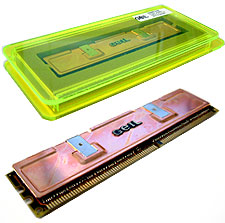We like
it when a manufacturer goes out of their way to "wow" the customer with
packaging. Like Mushkin's neat air packaging, the GEIL memory came incased in a
very cool looking neon
green plexyglass case that certainly grabs attention!
 Inside
the well protected case sits the PC3500 DDR module in a vacuum sealed
in a static bag. Below the memory is a quick FAQ on how the memory works,
possible problems you might have and how to remedy them. After talking a bit to GEIL, I found out that they actually
produce their own DRAM modules and DIMM PCB's.
Inside
the well protected case sits the PC3500 DDR module in a vacuum sealed
in a static bag. Below the memory is a quick FAQ on how the memory works,
possible problems you might have and how to remedy them. After talking a bit to GEIL, I found out that they actually
produce their own DRAM modules and DIMM PCB's.
GEIL say "this is the only way to ensure the
highest quality parts" go into their memory. Whether this is true or not we'll
be finding out soon enough as we stress test the memory as far as it will
go.
As you can see from the pictures
the memory has some pretty heavy duty RAMsinks on it like the ones found on
Mushkin and OCZ memory. This is a pretty good idea since DDR RAM at high speeds
does get quite hot when it's naked. Looking at GEIL's website we see
that the PC3500 DDR is actually specially handpicked 6 ns modules that
require anywhere from 2.7V-3.0V to run at rated speeds with timings of 2.5CAS
6-3-3-2.
To be honest, here we're a
little concerned about the memory voltage requirements and possible motherboard compatibility because of it. Not many motherboards out there, Intel
or AMD, allow memory voltages above 2.8V. In fact the only ones that immediatly come
to mind are Epox motherboards - so if you decide you
want to tweak the voltage above 2.8V you'll need to look in that direction.
We tested with an Abit Intel motherboard at 2.8v and that worked just
fine.

Compatibility, Testing
and Overclocking:
We usually test all DDR memory on AMD based systems, but the
GEIL PC3500 didn't seem to like the Epox 8K3A+ test motherboard. Even with
the motherboard at stock speed (133 MHz FSB, 166 MHz memory) the GEIL PC3500 wouldn't POST
until 3.2V worth of voltage was applied to the memory!
After
playing with it for about an hour the highest stable speed I was
able to attain with the most aggressive memory timings (2-5-2-2-1) was 176 MHz FSB.
With the most conservative, 186 MHz. 30 MHz away from the 216 MHz GEIL
claims the memory can run at. We tried running the memory in other AMD based
DDR boards and found we still had some compatibility problems.
"Why don't you use an Intel
based systems to test memory?"
I get asked that question
a lot from readers here, and from the newsletter, and the reason behind
that is that CPU speed affects
memory bandwidth scores.
Since all
Intel multipliers are locked, when you raise the FSB to test memory you're
also raising the CPU speed. Here's an example (using AMD systems though because I only have
one P4 test processor), using the Epox 8KHA+ with an AthlonXP 2000+ we get memory
bandwidth scores of 2014MB/s ALU / 1903MB/s FPU. Using an AthlonXP 2100+ (only 66
MHz faster then the XP2000+) the memory bandwidth is 2048 MB/s ALU /
1970 MB/s FPU.
Am I just being trivial or picky here? Just
imagine how different the bandwidth would be if the CPU's were running 200 MHz,
500 MHz or even 1 GHz faster? This doesn't just affect SiSoft Sandra memory
bandwidth scores, but also skews other benchmarks as well because the CPU speed
is now higher.
That
being said we did use a Pentium 4
system to test the memory and it ran flawlessly on the test Abit BG7 (i845G)
with a P4 1.6A. Enabling the 4/5 memory divider (making the memory run faster
then the FSB) we were able to push the FSB up to 167 MHz before our
CPU maxed out. The final memory speed we were able to attain
was 417 MHz, but we're sure we could have gone higher if the CPU not max out.
Everything was with the most aggressive memory timings enabled in the BIOS as
well!
It was
interesting to see that Sandra Identified the stick as GEIL's PC3200
model.
Update:
We were just informed by GEIL that they're
currently working with Epox to try and fix the compatibility issues that we
ran into with our testing. =)

